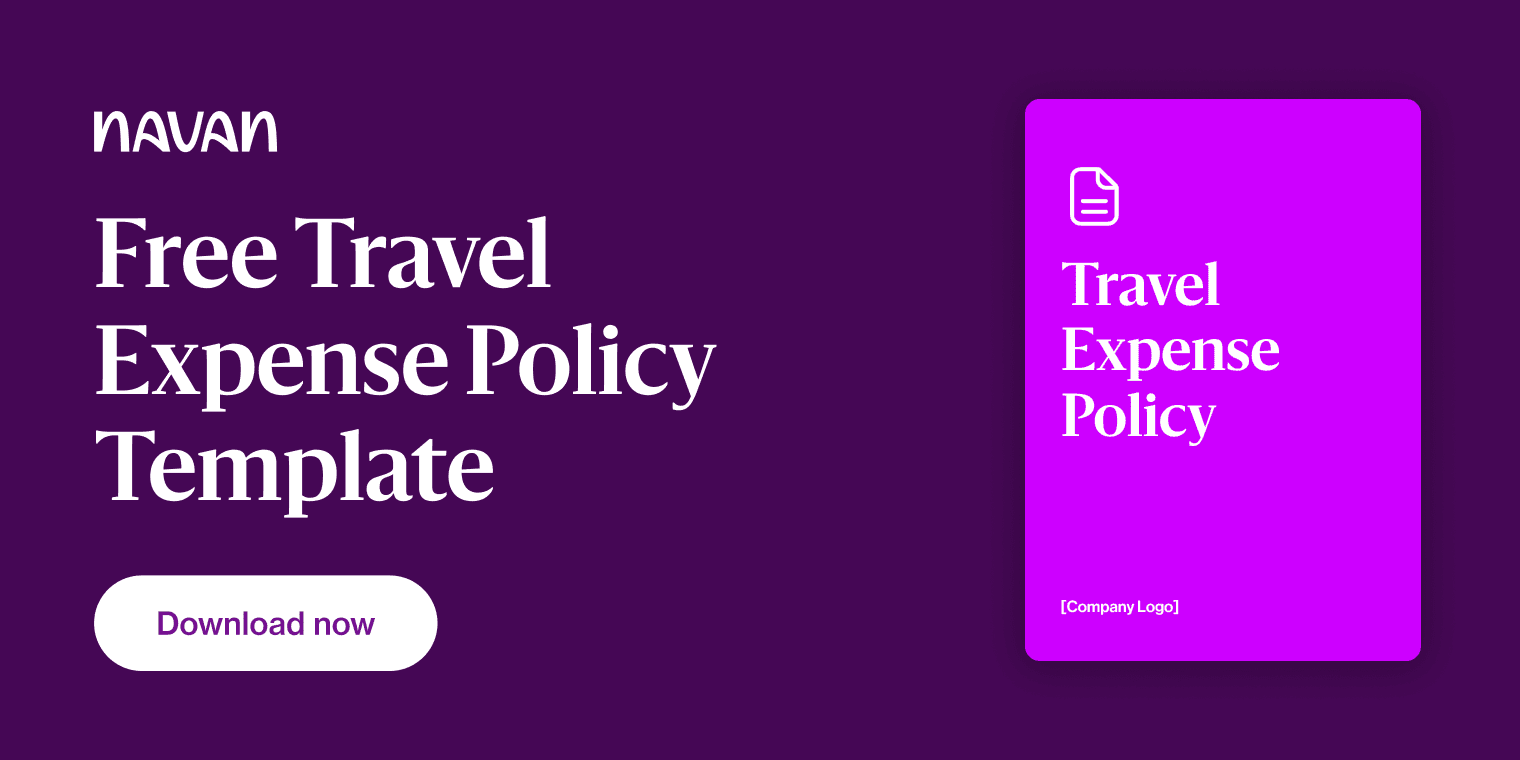Per Diem Policy: A Guide to Simplifying Corporate Travel Expenses

Samantha Shankman

In this era of increasing globalization and rising business travel costs, companies are always looking for ways to streamline expense management while maintaining compliance and efficiency.
One of the most effective solutions? A per diem policy — a structured approach that sets daily allowances for employees traveling on business and covers expenses such as lodging, meals, and incidentals.
For companies managing frequent corporate travel, per diem policies provide a predictable, scalable, and cost-effective alternative to traditional expense reimbursement methods. Instead of requiring employees to track and submit individual receipts — a process often mired in inefficiencies — businesses can issue fixed daily allowances that eliminate paperwork, simplify financial reporting, and reduce the risk of overspending.
Not all per diem policies are created equal, however. This guide explores how businesses can implement an effective per diem policy, optimize travel spending, and leverage modern expense management solutions like Navan Expense to enhance efficiency and compliance.

What Is a Per Diem Policy?
A per diem policy provides employees with a fixed daily allowance for business travel expenses that covers costs such as meals, lodging, and incidentals. Rather than requiring receipts for every expense, businesses set standardized per diem rates to simplify reimbursement, help ensure compliance, and control costs.
Standard Components of a Per Diem Policy:
While per diem structures vary by company and destination, most policies cover three main categories of expenses:
Meals
Food expenses can add up quickly during business travel, which is why per diem policies set daily meal allowances. These allowances are often broken down into breakfast, lunch, and dinner, with rates that may fluctuate based on location. For example, employees traveling to high-cost cities like New York or London might receive higher meal allowances than those visiting smaller towns. Some businesses also offer partial per diem rates for travel days or conferences where meals are provided.
Lodging
Accommodations are another major travel expense covered under per diem policies. Instead of requiring employees to book within a specific budget and submit receipts, companies provide a fixed lodging allowance based on regional pricing guidelines. In some cases, lodging is bundled into an overall per diem rate, while other policies set separate reimbursement limits for hotels. This approach gives travelers the flexibility to choose accommodations that meet their needs while keeping costs predictable for businesses.
Incidentals
Even the smallest travel expenses can add up, which is why per diem policies include an allowance for incidentals. This covers minor but necessary costs like hotel tips, baggage fees, and service charges. Since these expenses are typically low in value and difficult to track individually, per diem policies eliminate the need for employees to submit receipts — saving time for both travelers and finance teams.
For official per diem rates, check out Navan’s per diem calculator.
Why Are Per Diem Policies Important for Businesses?
A well-structured per diem policy does more than just set daily spending limits — it streamlines expense management, keeps budgets predictable, and makes business travel smoother for everyone involved. Let’s explore the advantages.
Advantage 1: Better Cost Control
For companies, having a clear per diem structure means better cost control. Instead of dealing with inconsistent and unpredictable travel expenses, finance teams can allocate a fixed amount per day, reducing the risk of overspending. This approach not only helps manage cash flow but also simplifies forecasting for future travel costs.
Advantage 2: Simplified Expense Reporting
Expense reporting also becomes far less of a headache. Without a per diem policy, employees need to track every meal, coffee, or taxi ride, collecting receipts along the way. But with a per diem in place, there’s no need for meticulous receipt submissions. A straightforward daily allowance means fewer reimbursement requests, less back-and-forth with finance teams, and more time spent on actual work.
Advantage 3: Improved Employee Experience
From an employee perspective, per diems remove the financial stress of fronting travel expenses. Instead of waiting weeks for reimbursement, employees get their travel funds upfront, making it easier to budget while on the road. And since the policy sets clear expectations, there’s no confusion about what’s covered and what’s not.
In short, per diem policies benefit everyone — finance teams get cleaner expense management, employees get a more seamless travel experience, and businesses maintain better control over their travel budgets.
How Do Per Diem Policies Work?
Businesses set per diem rates based on industry standards and location-specific costs to help ensure fair and predictable travel allowances. Some companies use standardized rates that apply across all locations, while others adjust allowances based on regional expenses to account for variations in lodging and meal costs.
The distribution of per diem payments can vary. Some businesses provide funds in advance to minimize out-of-pocket expenses for employees, while others reimburse costs after travel based on submitted records and receipts. Alternatively, companies can issue corporate cards, which help streamline expense tracking.
From a compliance standpoint, per diem payments are generally non-taxable as long as they align with government-set rates and employees submit basic documentation, such as travel dates and locations.
How to Create an Effective Per Diem Policy for Your Company
A clear and well-structured per diem policy is essential for creating transparency, controlling travel costs, and maintaining compliance with financial regulations. Below are some key steps and best practices for drafting a policy.
1. Determine Per Diem Rates Based on Location and Business Needs
Setting appropriate per diem rates helps employees receive fair compensation for business travel expenses while helping to prevent overspending. Companies typically use one of two approaches:
- Many businesses use rates established by the U.S. General Services Administration (GSA) for domestic travel and the U.S. Department of State for international travel. These rates reflect the typical cost of meals, lodging, and incidentals based on location.
- Some businesses set their own per diem rates based on internal financial policies, travel budget constraints, or historical spending data. This approach offers flexibility but requires careful analysis to help ensure fairness and compliance.
Navan’s Per Diem Calculator
Navan’s Per Diem Calculator empowers finance teams, travel managers, and business travelers to quickly determine the per diem allowance for any U.S. location. Just enter a destination, and the tool provides estimated rates for lodging, meals, and incidentals based on government benchmarks.
Try the Navan Per Diem Calculator now to find per diem rates for your next business trip.
2. Define Covered and Non-Covered Expenses
A strong per diem policy should clearly outline which expenses are covered and which are not. Explicitly defining covered expenses helps employees understand how per diem allowances should be used, which helps to reduce disputes and compliance issues.
Typical inclusions and exclusions are:
- Meals and snacks (breakfast, lunch, dinner)
- Lodging (hotels, extended stays)
- Incidental expenses (tips, service fees, parking)
- Alcoholic beverages
- Personal entertainment (movies, excursions)
- Luxury accommodations or upgrades
- Non-business-related expenses
3. Establish Distribution Methods for Per Diem Payments
Businesses can issue per diem allowances in different ways, depending on financial policies and employee preferences. For example, a professional services firm may provide corporate cards to senior consultants while offering per diem advances to junior employees traveling for the first time. The primary methods of per diem payment distribution are:
- Advance payments: Employees receive per diem funds before traveling. This is ideal for companies that want to minimize out-of-pocket employee expenses.
- Reimbursement method: Employees pay for expenses upfront and are reimbursed after submitting records and receipts. This helps ensure compliance but may burden employees financially.
- Corporate cards: Companies issue prepaid or corporate credit cards that employees use for eligible expenses to streamline tracking and expense reporting.
4. Align with IRS Guidelines and Tax Compliance
To help ensure per diem payments remain
- Travel dates and business purpose
- Destination and duration of the trip
- Expense categories and amounts
If per diem payments exceed the IRS’s standard rates, the excess amount is considered taxable income for employees.
Global companies might adjust their per diem policies to align with both IRS and European VAT regulations, in order to maintain compliance in multiple regions.
5. Integrate with Expense Management Tools for Automation
Modern companies are leveraging automated expense management platforms like Navan Expense to manage per diem payments efficiently. The benefits of using an integrated system include real-time tracking of travel expenses, automated policy enforcement to help prevent overspending, and seamless integration with accounting software for accurate financial reporting.
Top Benefits of Implementing a Per Diem Policy
A well-structured per diem policy simplifies business travel expenses, improves financial efficiency, reduces administrative burden, and enhances employee experience by offering:
1. Financial Efficiency: Accurate Budgeting and Cost Control
Per diem policies help businesses predict and control travel costs more effectively than traditional expense reimbursement methods. By setting fixed daily rates, companies can help prevent unpredictable or inflated expense claims, improve budget forecasting for travel expenses, and reduce overall business travel costs.
2. Time Savings: Faster Reimbursements and Expense Approvals
With a per diem policy, employees and finance teams no longer need to track and submit individual receipts for every meal, taxi ride, or incidental cost. This leads to faster reimbursement processing for employees, reduced administrative workload for finance teams, and elimination of disputes over receipt validity or expense categories.
3. Improved Compliance: Simplified Tax and Audit Readiness
Companies that adhere to IRS per diem guidelines benefit from non-taxable reimbursements, reducing compliance risks and avoiding unnecessary tax burdens. With proper documentation, businesses can help ensure audit-ready financial records, reduce tax liabilities for both the company and employees, and maintain transparent and consistent travel policies.
4. Enhanced Employee Experience and Satisfaction
Employees benefit from per diem policies because they eliminate out-of-pocket expenses and provide flexibility in using travel funds. Key advantages for employees include less financial stress from waiting for reimbursements and greater autonomy in choosing how to spend their per diem. Plus, there’s no need to track receipts for smaller expenses.
5. Scalability: A Sustainable Travel Expense Model for Growing Businesses
For companies expanding their business travel operations, a per diem policy provides a scalable and repeatable approach to expense management. As businesses grow, automating per diem policies through travel and expense platforms helps maintain consistent expense tracking across departments, real-time budget oversight for finance teams, and improved cost control without additional administrative burden.
5 Tips for Employees Using Per Diem Allowances
A per diem simplifies travel spending, but employees still need to use their allowances wisely to stay compliant with company policies. Here’s how to make the most of per diem while keeping things smooth with finance teams.
1. Understand Spending Limits
Before your trip, take the time to review your company’s per diem rates and what they cover. Some policies provide a lump sum for meals, lodging, and incidentals, while others separate these categories with specific limits. Rates can also vary based on location — business travel to major cities often comes with higher allowances than smaller towns. Knowing your daily limit upfront prevents surprises and helps you stay within budget.
2. Track Expenses (Even Without Receipts)
One of the biggest perks of per diem is that you typically don’t have to keep receipts for every purchase, but that doesn’t mean you should ignore recordkeeping altogether. Jot down key details like travel dates, destinations, and any employer-required documentation. If your company follows IRS or government per diem guidelines, maintaining accurate records helps ensure compliance and avoids potential tax issues.
3. Choose Cost-Effective Options
While per diem gives you spending flexibility, it’s still smart to be mindful of costs. Choosing reasonably priced hotels, restaurants, and transportation options helps stretch your allowance further. For example, if your lodging rate is separate from your meal per diem, opting for a hotel with free breakfast can free up more of your meal budget for other expenses. Finding small ways to save can make business travel more comfortable without exceeding company limits.
4. Check Company-Specific Guidelines
Not all per diem policies are the same. Some companies allow employees to keep any unused per diem funds, while others require reimbursement for unspent amounts. There may also be restrictions on what qualifies as an incidental expense or whether meal per diems apply to alcohol purchases. Before your trip, review any company-specific rules to avoid confusion or compliance issues later.
5. Submit Travel Records Promptly
Even though per diem eliminates most receipt tracking, employees still need to submit travel records within the required timeframe. This helps finance teams verify compliance, process reimbursements quickly, and ensure the payments remain non-taxable. Delayed submissions could lead to per diem being classified as taxable income, reducing your take-home pay. To avoid complications, submit any required forms or documentation as soon as your trip ends.
Following these best practices helps you get the most out of per diem while keeping your company’s travel policies in check — so you can focus on your work, not expense reports.
Meet Navan
Navan simplifies corporate travel expense management with integrated per diem solutions. Businesses using Navan benefit from automated tracking, real-time policy compliance, and seamless reimbursements, helping them optimize travel spending while reducing administrative workload.
Companies around the globe choose Navan for per diem management for:
- Automated expense tracking
- Real-time compliance monitoring
- Seamless reimbursements
FAQ
1. What is a per diem policy, and why is it used?
A per diem policy sets daily allowances for business travel expenses, streamlining reimbursements and supporting cost control.
2. How do companies set per diem rates?
Rates are typically based on government guidelines from the GSA or company-specific travel budgets.
3. Are per diem allowances taxable?
If employees submit required documentation, per diem payments generally remain non-taxable. The IRS per diem guidelines provide more information.
4. What are the best practices for creating a corporate per diem policy?
Define clear rates, integrate expense management tools, and support compliance with tax regulations.
5. How can employees help ensure compliance with per diem policies?
Follow company guidelines, track expenses, and submit travel records promptly.
Final Thoughts
A structured per diem policy simplifies corporate travel expense management. Companies implementing well-defined policies can enhance compliance, control costs, and improve employee experience.
Sign up for Navan Expense today to experience a new world of productivity and potential.
This content is for informational purposes only. It doesn't necessarily reflect the views of Navan and should not be construed as legal, tax, benefits, financial, accounting, or other advice. If you need specific advice for your business, please consult with an expert, as rules and regulations change regularly.
Frequently Asked Questions
More content you might like
Take Travel and Expense Further with Navan
Move faster, stay compliant, and save smarter.


